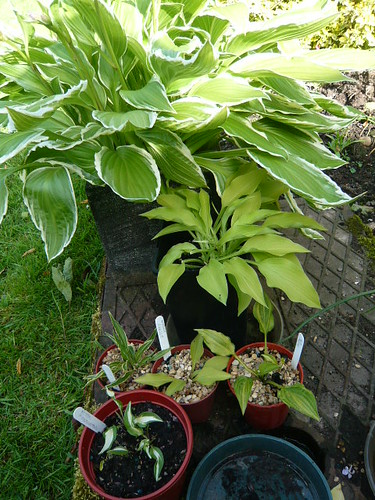Dwarf Hostas for your Garden
Hosta tip – keep a cordon sanitaire of rough gravel or broken egg shells around plants to deter slugs.
Call them miniature, small, dwarf or even bonsai Hostas these little darlings will give you bucket loads of pleasure. many dwarf plants are difficult to cultivate and retain but I find Hostas are hospitable and accommodating
I have just taken to small Hostas having bought a couple cheaply at a local fete.
From the RHS library I borrowed ‘The Book of Little Hostas, 200 Small, Very Small and Mini Varieties.’ and already had a couple of other Hosta books but no small plants.
I realised that I was not going to aim for a massive collection of varieties as breeding is introducing new cultivars at a prodigious rate.
So my intention is to grow and display a selection of varied, colours, shapes and sizes and see how I get on.
First Small Hosta Acquisitions
- Hosta venusta ‘Masquerade’ A popular variety by all accounts that originally grew in mountainous regions shaded by rocks. It should create a 6″ high dense mound of tear drop shaped, textured leaves. They have a creamy white center and bright green edges to the leaves with purple/blue summer flowers.
- The next variety is labeled ‘a mame’ a variety I can’t find in any reference book. As I know the grower I can ask if I have read the label incorrectly or if it is an unregistered name. The young plant has leaves of green with yellow edges.
- Hosta pulchella ‘Stiletto’ is another well known variety in hosta circles. The roots are rhizomatous from one of the smallest species. I am told to expect tiny mounds of thin rippled, wavy leaf of satiny mid-green and cream fading to white on the edges . The flowers will be purple all being well. Other varieties from this species include Wiggle Worms, Shining Tot or Kifukurin Ubatake.
- Hosta Hydon Sunset will have heart-shaped yellow leaves. It is a fast grower needing some sun for good yellow color. Flowers lavender-purple.
- Hosta gracillima is a species that I have yet to acquire.
Growing and Displaying
- I am exercised about how to display the hostas so will grow them in pots this year and look for interesting containers.
- I am looking for ideas to keep them in pots or a raised environment for the longer term.
- Soil should be slightly acidic with an open texture and water retention capacity.
- Roots of small hostas are shallow and benift from a mulch.
- A raised bed seems to be a good idea when I want a display in the main garden.
- Hostas survive well from frosty conditions but freezing and thawing can create too much water to encourage rotting. For that reason a mulch will protect your plants through winter.
- Do not over feed. If soil is poor or gets impoverished try a slow release fertiliser.
Sources
The Hosta Library seed sowing, division and micro propagation.
British Hosta & Hemerocallis Society
Diana Grenfell author of New encyclopedia of Hostas has to a National Plant Collection of miniature hostas at her Gloucestershire home.
Luckily, hosta collectors now have access to new small hostas that are ideal for containers, roof terraces, windowsills and other small spaces. The Book of Little Hostas features a handpicked selection of diminutive hostas to direct collectors towards the right plant for their needs. Beautifully illustrated and highly informative, The Book of Little Hostas will inspire hosta-holics and gardeners alike.

The Book of Little Hostas: 200 Mini, Small and Very Small Varieties by Michael Shadrack and Kathy Guest Shadrack from amazon

